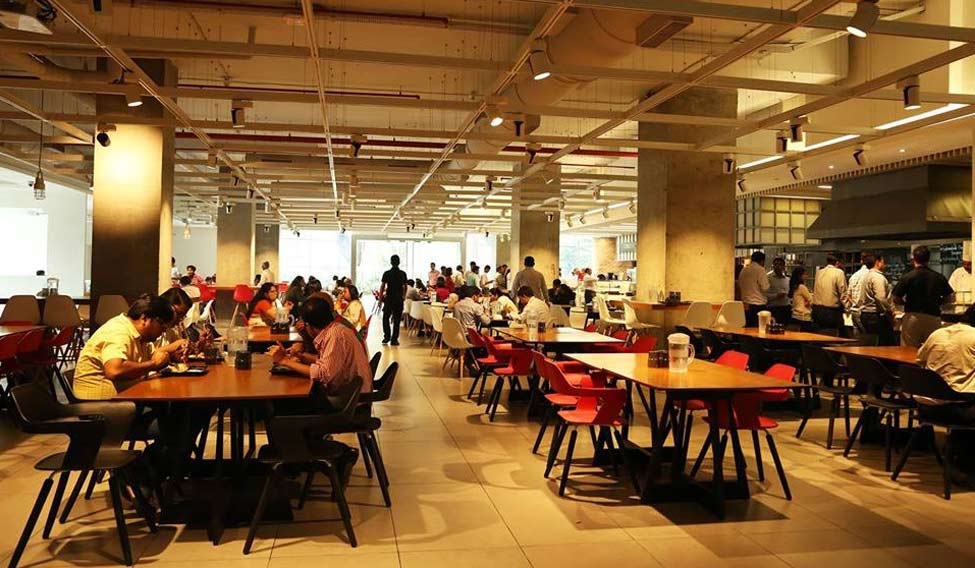Divya, a marketing professional based in Bengaluru, was on a four-year career break after the birth of her daughter. When the child started pre-school, Divya decided it was time to bid adieu to her career hiatus. However, juggling household responsibilities and work life was quite a scary thought for her.
Fortunately, finding a job was not as difficult as she had anticipated. What proved to be a bigger relief for her was that the multinational company that hired her had a well-maintained round-the-clock food court. “Having a quality food facility at your office is a great relief. It takes a lot of tension and burden off your shoulders,” says Divya. “Most of the days, I have to bother only about dinner at home and not breakfast and lunch. Also, it helps me give more attention to my daughter in the mornings.”
Even until a decade ago, such canteens and facilities providing healthy food options for employees were a rarity in India. Indians were used to carrying their dubbas to office or heading to nearby restaurants to satiate hunger pangs. Often, the latter option came with its share of health and hygiene risks.
However, things have now changed for the better. With the advent of multinational companies, one of the biggest trendsetters in the Indian job landscape was companies opening cafeterias and canteens for its employees.
Beyond catering to the basic need of food, corporates are, interestingly, looking at food services as a motivational factor for their employees. “Food is an employee engagement activity, to ensure their well-being. It is certainly a motivational factor,” says Ajay Bhatt, head, administration and facilities at Godrej. More and more companies are seeing this as an investment.
The company’s Mumbai campus includes a food court, cafeteria and Starbucks outlet. “We ensure that these facilities are available to the employees, irrespective of their buying/selling power. The rates are not as high as outside, but without any compromise on quality,” says Bhatt.
India is among the top three Asian nations for corporate food catering with a market size of $3 billion. The space is hotting up with even multinational commercial catering and food services companies like Elior, Sodexo and Compass Group making their presence felt in the country. For instance, French company Elior which ventured into the Indian market in 2016 claims 16 per cent growth rate in India. “Corporate food catering space is one among the fastest growing industries in India. Also, India has one of the highest growth rate in the world in the space,” says Sanjay Kumar, CEO, Elior India. Its clientele includes Cisco, Microsoft, McKinsey, Shell, Daimler and Pfizer, among others.
So what are the common demands from corporates when it comes to catering? While many look for home-style food as daily meal options including healthy alternatives like salads or calorie-driven meals, clients who pay a premium expect an extensive menu comprising a mix of Indian, Asian, Continental and Mediterranean. A health bar that supplies freshly-squeezed juices and salads is another added attraction these days. Hence, it is not surprising when Abhijit Bajaj, an analyst at an MNC in Chennai says, “I look forward to Tuesdays each week when we are served authentic chole bhature. The real taste of chole bhature was something I missed ever since I moved to south. But not any more.”
Corporate food catering works on two major models in the country. One, where the company takes the entire cost, and two in which it is partially subsidised. Surprisingly, there are companies in the country that spend as high as Rs 675 per meal per person in India, says Sanjay. Some of these companies also stress on the importance of ‘satiating any employee’s hunger within 10 m of her desk’ by policy.
To a large extent, more women joining the working bracket is also contributing to the growth of the market. India has traditionally been a patriarchal society, where women were often confined to managing household chores. This has begun to change with women becoming more career-oriented and seeking a work-life equilibrium.
Apart from these, changing consumption patterns are also driving corporates to take more interest in their employees’ health. Contrary to the practice of having the personnel and administration division maintaining the department, most of the companies these days have a dedicated specialist for running such food spaces. At Godrej, for instance, it is even integrated to its health and wellness initiative. Doctors who conduct employee medical check-ups at the company, suggest diet plans which they try to deliver in-house. In addition, a qualified chef ensures that the menu is designed according to nutritional values. Calorie values of each item are also displayed along with the dish.
This fast-maturing market has become more of a level-playing field now. There is impending consolidation. While there are a number of small players, it is not sustainable for long because a small marketer can’t often afford cheaper prices. Consolidation helps in the emergence of more serious players. “We struggle not on price points but on technology—to maintain temperatures. Even a one-degree drop can impact the quality of food provided,” adds Sanjay.







